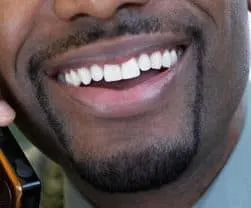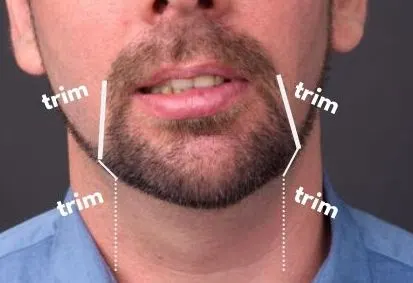Sometimes, the slightest of amendments can have quite a profound impact. The simple removal of the smallest patch of hair can add just enough to make a very common style more interesting. That’s what the Goatee Without Soul Patch is all about.
It isn’t a very complex style worthy of in-depth discussion. That’s why this article might seem relatively short. But don’t let that influence your opinion of it, because its simplicity is what makes it so brilliant.
You’re about to learn more than you ever thought you would about this style. I’ve written pretty extensively about goatees in the past. There are just so many different variants that it can be hard to keep track of them.
As is usual, I’ll first go through what it actually is. Then, I’ll dive deep into how to trim it and achieve it with a simple set of tools. Finally, I’ll finish off by giving you some grooming tips to elevate your goatee to new heights.
Let’s get started.
What Is A Goatee Without A Soul Patch?
Before delving into this goatee variant, let’s briefly talk through what a “goatee” is in the first place.
A goatee is, in essence, a style that consists of hair on the chin, but not on the cheeks. If a style follows this very broad principle, an argument could be made for labelling it a goatee.
There are, of course, some outliers, as well as a lot of scope for debate. But in general, by following this principle you can’t go too far wrong.
The traditional definition of a goatee is simply a tuft of hair on the chin and nowhere else. However, the modern notion of a goatee frequently incorporates a mustache as well.
The chin beard and mustache may be connected or disconnected – this is one of the many ways in which goatee styles can vary.
But let’s turn our attention to the guest of honor – the “soul patch”. The soul patch is a tiny little patch of hair that lies immediately beneath the bottom lip.
It grew famous in the ‘40s due to its popularity among the beatnik generation of artists, poets, and musicians.
Most goatees do consist of some hair beneath the lower lip, but this isn’t due to design. It’s usually just due to a lack of trimming in the area. But a well-defined soul patch that’s neatly carved out can actually complement a goatee very nicely.
Check out this article on the goatee with soul patch to find out more about this style.
But the goatee without a soul patch makes it a point to actively remove this little bit of hair. What results is a more shapely, modern looking goatee style. It leads to more of a box-like shape to the goatee which can look mighty sophisticated indeed.
It’s generally a style favored by younger men, although this is somewhat of a generalization.
It does, as you’d expect, come with a slightly increased maintenance requirement. Simply because there’s just a little bit more trimming necessary to complete it. It’s usually necessary to shave over it as well to get that ultra-sleek finish.
But we’re just about to come onto that.

How To Trim A Goatee Without A Soul Patch
This is a simple, straightforward, step-by-step routine you may have grown accustomed to from my other posts. There’s nothing too complicated about this style – that’s the beauty of it.
You’ll need an electric trimmer to pull this off. However, if you’ve got very short facial hair you’d probably get away with a razor.
1. Trim everything down
Before we carve out a glorious goatee outline, we need to trim all of the hair down to the same length. That includes hair that will eventually be shaved off, like the cheek and neck hair.
This will make it a lot easier to shape a nice, natural-looking goatee outline in the next step. Don’t worry – the soul patch removal will be soon too.
In order to do this with precision, you’ll need an electric trimmer. If you don’t already have one, have a look at the Philips Norelco Oneblade QP6520/70 on
At this point, you’ll need to decide upon the length you’ll want your goatee to eventually be. This is entirely down to personal preference, but let’s assume a length of 8mm for now.
Set your trimmer’s length guard to your length of choice (in our case 8mm), and start trimming your entire beard down.
Try to achieve an even yet natural-looking trim by adjusting the length very slightly in different parts of the beard. You don’t have to focus too much on the cheek and neck hair, as you’ll be shaving these parts later in any case.
But if your chin beard is thicker than your mustache, for example, you may want to trim it down by 0.5mm to 1mm more. This will lead to your goatee looking more even at the end.
2. Shape your goatee
It’s time for the fun part. What you use to shape your goatee outline is entirely up to you. I would use the naked blade of my electric trimmer – in other words, without any guards attached.
However, if your facial hair is essentially stubble (< 5mm), you could even get away with using a manual razor. This would save you time, as you’d have to use it to shave the cheeks and neck afterward in any case.
But anyway, start shaping your goatee using your blade of choice and trim any hair that lies outside it. Yes, this is the point where you start tackling your cheek hair. Be careful not to make your sideburns too short.
Now, the tricky part is making the goatee appear symmetrical and natural. One of the most common mistakes is to make the sides of the goatee too vertical. This can make it look way too narrow.
The sides of the goatee should be considered simply a natural extension of the mustache itself. In other words, follow the sides of the mustache downward in a gentle curve to carve out your goatee sides.

3. Don’t forget the neckline
Although the neckline of a goatee is very narrow indeed, it’s still important to have it lying at the correct height. Having it too high or too low is a sinful beard grooming faux pas.
The neckline should lie approximately two finger-widths above your Adam’s Apple. This is the lump in the middle of your neck that moves up and down when you swallow.
The neckline should have a gentle upward curve toward each side. The sides of the neckline should end at the point where the sides of the goatee meet them from above.
Once again, trim any hair that lies outside and beneath your neckline outline. This is the point where you tackle that neck stubble.
4. Skilfully remove the soul patch
You may have wondered when we’d get to the main event. In order to trim a goatee without a soul patch, well, you’ve got to remove the soul patch.
This would be a good time to do it. You’ve trimmed the outline of your goatee and set a solid neckline.
Using your trimmer blade or razor blade, remove any hair that lies immediately beneath your lower lip. How far down the chin you choose to trim is down to personal preference.
You could even trim as low down as a finger-width above the tip of your chin. This would lead to a box-like appearance to the chin beard which some men prefer.
The objective here is to make the removal appear intentional, however. In order to do this, work with precision. Focus on achieving neat, straight borders around the previous site of the soul patch.
In other words, if you’re aiming for a box-shape make the borders nice and sharp.
5. Shave the areas outside of your goatee
If you’ve used the naked blade of your trimmer, chances are you’ve still got some stubble you need to take care of.
This will be on your cheeks, your neck, as well as where the soul patch previously was.
You could reasonably leave it there and it would still look pretty good. But if your objective is perfection, you’ll want to shave for ultra-sleek results.
Conclusion
It’s a style you may not have considered in the past. Goatees are incredibly common, but it’s their intricate variations that make them so interesting.
There are many – the goatee with stubble, the goatee with sideburns, etc. Trust me, the list goes on.
“Goatee” should be considered a genre, more than a specific style. There are just too many options to justify painting them all with the same brush.
Hopefully, this tutorial has provided you with one more style to add to your growing repertoire.
Importantly, have fun with it. Experimentation is the key to beard grooming success.
Ready Sleek founder. Obsessed with casual style and the minimalist approach to building a highly functional wardrobe. Also a fan of classic, vintage hairstyles.






